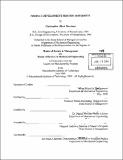| dc.contributor.advisor | Nelson Repenning and Daniel Whitney. | en_US |
| dc.contributor.author | Morrison, Christopher Albert, 1972- | en_US |
| dc.contributor.other | Leaders for Manufacturing Program. | en_US |
| dc.date.accessioned | 2006-11-08T16:23:59Z | |
| dc.date.available | 2006-11-08T16:23:59Z | |
| dc.date.copyright | 2000 | en_US |
| dc.date.issued | 2000 | en_US |
| dc.identifier.uri | http://hdl.handle.net/1721.1/34711 | |
| dc.description | Thesis (S.M.)--Massachusetts Institute of Technology, Sloan School of Management; and, (S.M.)--Massachusetts Institute of Technology, Dept. of Mechanical Engineering; in conjunction with the Leaders for Manufacturing Program, Massachusetts Institute of Technology, 2000. | en_US |
| dc.description | Also available online at the MIT Theses Online homepage <http://thesis.mit.edu>. | en_US |
| dc.description | Includes bibliographical references (p. 95-96). | en_US |
| dc.description.abstract | For many companies, new product development is a major component of growth. For many luxury goods, such as high-end automobiles, watches, or furniture, product development organizations focus on quality and ultimately, protection of the brand. Frequently, growth is created through incremental improvements to the existing platforms. However, many of these firms choose to expand into other geographic and demographic markets, rather than increase current market share to preserve price premiums and the exclusiveness of the brand. Customers buy the style of these products and firms who have created this style are reluctant to change the process that created it. Quantifying style is nearly impossible and thus, development requires a degree of "magic." However, new products may require more advanced technologies than the current product line and the question arises whether the company's traditional product development model will suffice. Continuous improvement of the development process is required to deliver these new products. However, few methodologies exist to assess and change such a highly ambiguous and cross-functional process. This thesis details a postmortem assessment process using a luxury goods company as a case study. This thesis addresses several areas that are not prevalent in documented processes. The first area is the collection and analysis of quantitative data, especially that which represents a decisionmaking process across the entire organization. The second area is a portfolio view rather than a project by project review. The utilization of this process for the case company led to determination of high leverage such as problem discovery predominantly at the prototype builds, problem prioritization and resolution, and concurrency of development. Cultural ramifications of a style driven company are also explored. Finally, a general framework for improvement across the organization is presented along with a discussion of the implementation process. | en_US |
| dc.description.statementofresponsibility | by Christopher Albert Morrison. | en_US |
| dc.format.extent | 96 p. | en_US |
| dc.format.extent | 8240857 bytes | |
| dc.format.extent | 8240613 bytes | |
| dc.format.mimetype | application/pdf | |
| dc.format.mimetype | application/pdf | |
| dc.language.iso | eng | en_US |
| dc.publisher | Massachusetts Institute of Technology | en_US |
| dc.rights | M.I.T. theses are protected by copyright. They may be viewed from this source for any purpose, but reproduction or distribution in any format is prohibited without written permission. See provided URL for inquiries about permission. | en_US |
| dc.rights.uri | http://dspace.mit.edu/handle/1721.1/7582 | |
| dc.subject | Sloan School of Management. | en_US |
| dc.subject | Mechanical Engineering. | en_US |
| dc.subject | Leaders for Manufacturing Program. | en_US |
| dc.title | Product development process assessment | en_US |
| dc.type | Thesis | en_US |
| dc.description.degree | S.M. | en_US |
| dc.contributor.department | Leaders for Manufacturing Program at MIT | en_US |
| dc.contributor.department | Massachusetts Institute of Technology. Department of Mechanical Engineering | |
| dc.contributor.department | Sloan School of Management | |
| dc.identifier.oclc | 45503116 | en_US |
